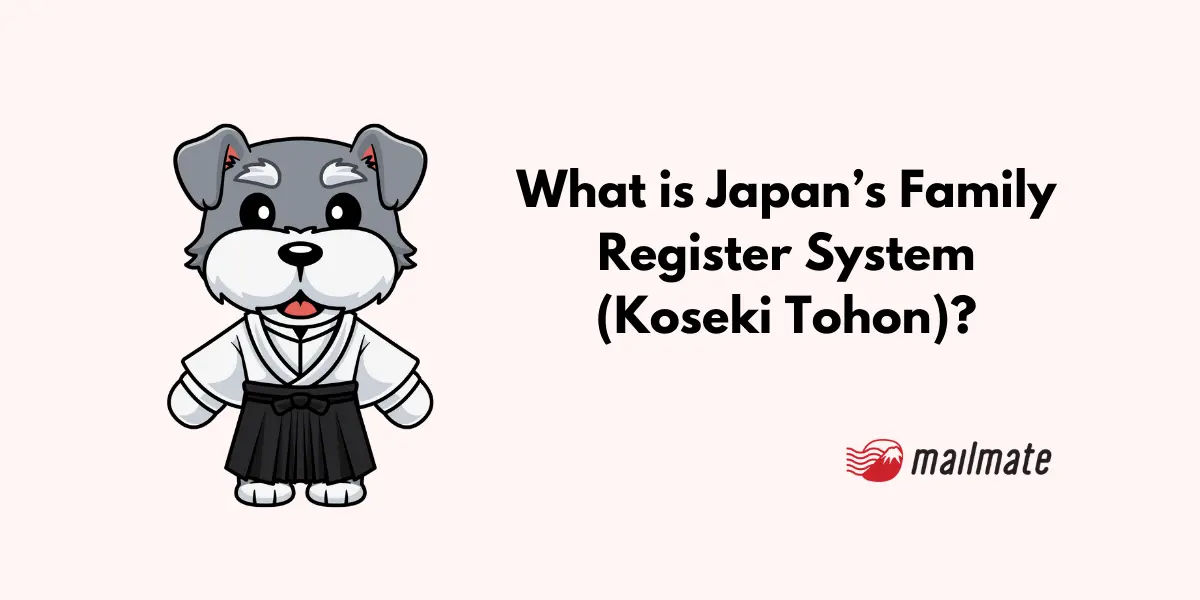What Is Japan’s Family Register System (Koseki Tohon)?

In daily life, it's not often that a copy of one's family register (戸籍 = koseki) is needed. However, if you are a Japanese citizen, there are several important occasions when a copy of a koseki is required to prove one's identity and family relationships according to Japanese law.
In this article, we'll cover what is Japan's family register system, different instances when citizens will need to provide koseki records, and how to acquire a copy.
What is Japan's family register system (戸籍 = koseki)?
A family register is an official document that notes births, deaths, and marriages in Japan.

The document contains details such as an individual's name, date of birth, registered domicile (本籍地 = honseki chi), marital status, the names and relationships of birth parents, and children's names.
When a child becomes independent or marries, they are removed from their parents' family register, and they create a new one in the ward where their marriage was certified (Family Register Act, section 9, 13).
All information recorded in a family register is based on statements by citizens to their local city office. Additionally, because only Japanese citizens have koseki family registry records, it also serves as a way to verify citizenship.
You can also fill out a 戸籍証明書等請求書 (Koseki Shoumeisho tou Seikyuu-sho) which allows you to request a family register certificate, along with other related documents.
Do foreign residents have a koseki?
Foreign residents are not subject to Japan's family register system. Therefore, they are not required to have a koseki. A foreigner married to a Japanese national will have their name, date of birth, and nationality listed in their partner's family register but will not have their own entry.
However, foreign residents are subject to the Family Register Act and are required to notify births, deaths, and marriages that occur in Japan to their local municipal office.
Foreign residents (same as Japanese residents) notify the office by filing the appropriate paperwork such as notification of marriage (婚姻届 = kekkon todoke), notification of child's birth (出産届 = shussan todoke), notification of death (死亡届 = shibou todoke). For Japanese citizens, these filed documents will automatically update their koseki.
If you have obtained Japanese citizenship through naturalization, you can either create a new family register or join a Japanese spouse's family register (Family Register Act, section 103).
Can descendants of Japanese citizens request a koseki from the city office?
If you can prove a familial relationship between you and your Japanese family members, then you are permitted to request your family register from the city office. This is often requested by descendants of Japanese citizens who wish to know more about their heritage.
Video “Basics of the Family Register (KOSEKI) #1” by IMS Legal Professional Corporation.
What is the purpose of a family register in Japan?
Family registers perform the following 3 crucial roles for municipal governments:
Serves to prove Japanese citizenship.
Verifies a person's identity.
Determines familial relationships.
When is a family register copy needed?
The following situations require submitting one's family register:
During inheritance procedures.
When creating a will.
Claiming life insurance.
When applying for pension benefits.
Applying for and renewing one's Japanese passport.
When registering marriage in a municipality outside of one's registered domicile.
Additionally, there are other times when a copy of one's family register is required, such as when filing for divorce, changing one's legal name, and adopting a child.
The 2 types of family register documents: koseki tohon vs koseki shohon
There are 2 types of family register documents:
a comprehensive copy of a family register (戸籍謄本 = koseki tohon) that includes all family records and
an extract of a family register (戸籍抄本 = koseki shohon) that contains a portion of the family register, such as information for 1 family member.
Depending on what you need the family register for, Japanese nationals will need to submit one or the other to complete certain official paperwork. Most procedures that require an individual to present a family register will usually disclose which one you should submit for the given situation.
Note: Sometimes, a comprehensive copy of a family register (戸籍謄本 = koseki tohon) is called a "certificate of all records” (全部事項証明書 = zenbu jiko shomei sho). The difference between these names depends on whether the municipality has computerized its family register system or not.
Who can file for a family register copy? How to get a koseki tohon in Japan?
Individuals listed in the family register, spouses, and immediate relatives can submit the required documents to obtain a copy. Foreign residents married to Japanese citizens can also apply for a copy of their partner's family register (Family Register Act, section 10).
In some cases, a proxy (代理人= dairinin) can submit the necessary paperwork to obtain a copy of a family register. (Depending on the situation and reasons behind the request, certain municipalities may not permit this.)
Is it possible to acquire a family register copy at any city office?
Individuals can only obtain a copy of their family register at the city office of one's registered domicile (本籍地 = honseki chi). A registered domicile (本籍地 = honseki chi) is the village, city, or town where the head of household chooses to maintain their family register.
If you don't know where your registered domicile is, you can find out by obtaining your certificate of residence (住民表=jumin hyo) from your city office.
It is possible to request a koseki tohon application form by mail, although it is most often applied for in person. In the future, My Number Card holders will be allowed to request family register forms from a convenience store.
Step-by-step how to get a koseki tohon in Japan in person
To get a family register at the city office, citizens fill out an application form (申請書=shinsei sho) and present it with other required documents. Required documents will depend on who is submitting the paperwork and specific guidelines of the city office.
Step 1. Prepare the required documents.
If you or your spouse (or direct relative) is presenting the application form for your family register, you will need the following:
Identification document(s), such as your driver's license, My Number card, passport, national health insurance card, etc.
Documentation showing the relationship to the person listed in the family register.
Note: If a proxy is submitting the application form on your behalf, they will need your power of attorney (委任状=inin jo), their identification document(s), such as a driver's license, My Number Card, passport, national health insurance card, etc., and a photocopy of the identification document(s) of the person granting the power of attorney.
Step 2. Download and fill out the application form.
This form will differ from city to city. Some cities have the application form available online. To find out if this is the case for your city, Google the terms: [your city name] + 戸籍謄本. If the form is not available online, then you must go in person to the city office and apply there.
Step 3. Go to the city office and submit your documents.
If all documents are in order, you will receive your family register on the spot after paying a set fee (1 family register form = ¥350 to ¥450).

Image. Minato-ku's family register application form.
Step-by-step how to request a family register by postal mail
Most cities allow you to submit the family register form by postal mail. If your registered domicile's city office permits this, these are the general steps:
Step 1. Download the koseki application form from your municipality's website.
Downloadable application forms for official documents and certificates are often available on the city office's website. Fill it out and set it aside. Also, make note of the municipality address to which you must send your paperwork.
If your permanent domicile (honseki) is outside Minato Ward and you need you're full family register certificate, you can fill out the Application for Certificate of Residence for Non-Minato City Residents.
Step 2. Make photocopies of the required ID-verifying documents to include.
Usually, one of the following: My Number Card, driver's license, health insurance card, residence card, etc.
Step 3. Create a fixed amount postal money order (定額小為替 = teigaku kogawase) issued by Japan Post Bank
This is a common payment method for official documents and certificates issued by the government sent by mail. In the case of family registers, the fee will depend on how many copies you need and the type of family register you are requesting (1 family register form = ¥350 to ¥450).
Step 4. Prepare a return envelope with your name, postal address, and 94-yen stamp affixed.
The required documents and submission methods may differ slightly depending on your registered domicile's prefecture, municipality, or city. Be sure to check the city office's website for which documents and submission methods are accepted.
Step 5. Receive a copy of your koseki tohon or koseki shohon in the mail.
If all your papers are in order, expect to receive a copy of your family register within one week to 10 business days. However, because this option can take some time to process, it may not be suitable if you're pressed for time and need the document immediately. In which case, apply in person at your registered domicile's city office.
Frequently asked questions
What is Japan's family register system (戸籍 = koseki)?
A family register is an official document that notes births, deaths, and marriages in Japan.
Do foreign residents have a koseki?
Foreign residents are not subject to Japan's family register system. Therefore, they are not required to have a koseki.
What is the difference between koseki tohon and koseki shohon?
A koseki tohon is a comprehensive copy of a family register that includes all family records. Whereas a koseki shohon is an extract of a family register that contains a portion of the family register, such as information for 1 family member.
Can I get an English translation of koseki tohon?
Services are available that provide English translations of the koseki tohon. Immigration lawyers and certified translators typically provide these services.
What is the purpose of the koseki tohon?
Family registers (koseki tohon) proves Japanese citizenship, verifies a person's identity, and determines familial relationships.
In closing
If you are a Japanese descendant, getting a copy of your family registry may prove enlightening and help you with the creation of a family tree.
If you need further assistance with communicating with a local government office, consider signing up to MailMate for exclusive access to our bilingual concierge service and your very own address in Japan.
Spending too long figuring out your Japanese mail?
Virtual mail + translation services start at 3800 per month. 30-day money-back guarantee.

